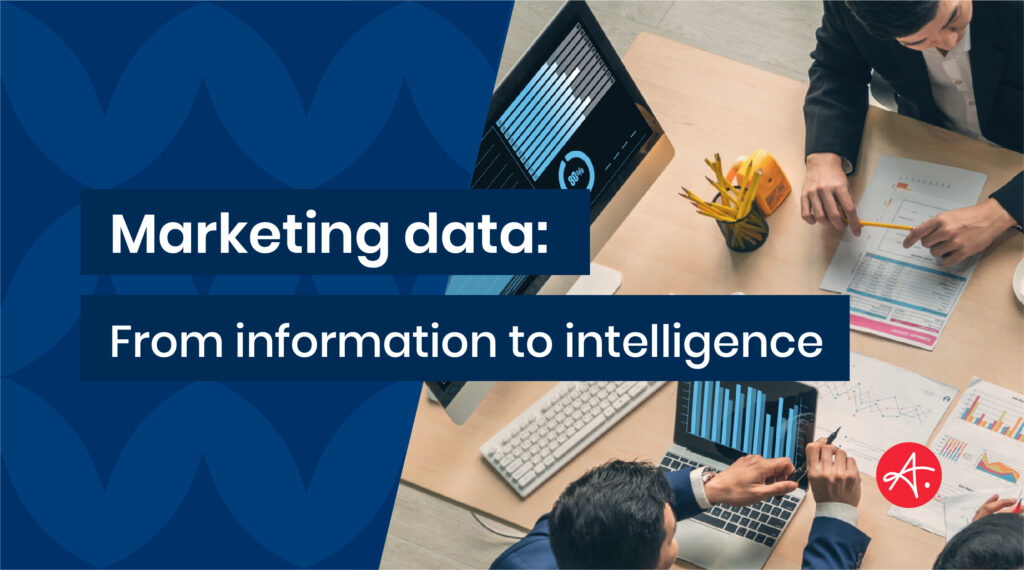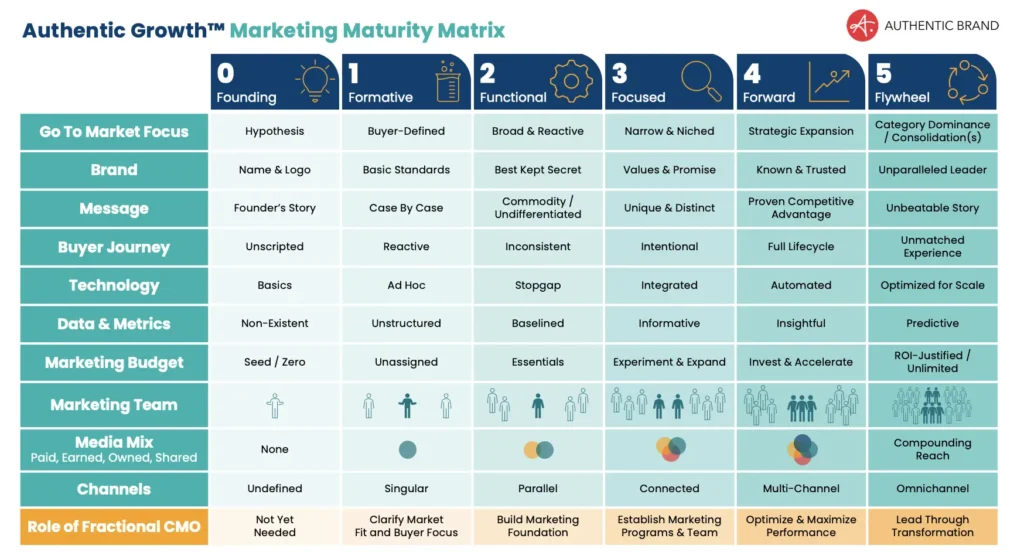Marketing data: From information to intelligence

Let’s talk about Marketing ROI.
Every growing business wants to know the ROI of its marketing investments. They want to predict, with certainty, how much they’ll get in return for various marketing activities. But few of these businesses have done the strategic work necessary to mature their data practices.
Instead, we often see this: With good intentions, entrepreneurial businesses hire a marketing leader, agency, or consultant and expect them to prove ROI in 90 days. But, often, business leaders aren’t really sure what they’re asking of these marketers. They don’t know what to measure, how to measure, or how long of a cycle it will take to generate a measurable impact. Unsurprisingly, the marketers hired often fail to meet the business’s (unrealistic) expectations.
In these situations, we turn to our Authentic Growth™ Marketing Maturity Matrix to demonstrate the stages of maturity every business must go through for ten distinct marketing attributes. Moving through the matrix requires discipline that doesn’t happen overnight, including how a company matures its data practices and metrics.

The path to marketing data maturity: Stages 0 to 5
As businesses mature, so should their approach to data and metrics. The following six stages show how a company can progress from having no data to generating insights that can help it predict the future.

Stage 0: Founding – Non-existent data
Day one of any business is a clean slate. There is essentially no activity and, therefore, no data to work with.
Businesses just getting started are trying to find their footing. They’re identifying their product/market fit, ideal customer profile, and how to describe themselves in their messaging. Often, they haven’t launched any organized sales and marketing activities. And if they have, measuring these activities might not teach them anything worthwhile because they don’t yet know what matters most to their business. Without knowing this, they can’t know what to measure and why.
How to mature to the next stage: Continue iterating on your business model and positioning until you identify your product/market fit. Defining your product/market fit is the first step to understanding what you need to measure and why.
What you’ll need: Clarity of offerings, ideal buyer focus, and market fit

Stage 1: Formative – Unstructured data
When a business is at the formative stage with its data, it creates a lot of unstructured data from various sources, including phone calls, emails, website visits, and meetings. The company is often focused on sales (and some marketing) activities. However, systems and processes likely haven’t been established to determine what activity data matters and how to organize it.
How to mature to the next stage: Begin to capture information but don’t overanalyze it. Instead, define what success looks like and how you’ll know when you reach it. Set specific goals and then determine what data you’ll need to measure whether you’re on track. Prioritize the capture and tracking of these data points.
What you’ll need: A clear definition of success, specific goals, and select measurables

Stage 2: Functional – Baselined data
When a business is at the functional stage with data, it’s beginning to capture the structured data it needs to create baselines. Structuring data requires companies to know which information they’ve been collecting is important. In other words, what information does the business need to track consistently to measure against its goals and KPIs? Some common examples include leads, sales, revenue, account growth, and retention.
Businesses in this stage need to give their data time to build. Companies can’t establish baselines from one day, week, month, or even a quarter of data. In fact, most companies need between 12 to 24 months of data before establishing an accurate baseline from which they can start to measure.
How to mature to the next stage: Continue building your structured data to have enough historical information to eventually generate meaningful reports.
What you’ll need: Systems (i.e., CRM, web analytics), processes, ownership (clarity of roles and responsibilities for data management)

Stage 3: Focused – Informative data
A business reaches the focused stage with its data when they’ve finally captured enough baseline data to allow useful reporting. The organization has enough information collected to ask questions about the data and find results such as total count, average, median, time, etc. For example, how long is our usual deal cycle? How many leads do we typically generate per month? And how many website visitors does our website get in an average week?
It’s important to remember that these data points on their own are just pieces of information. Another layer of data analysis must happen before companies can interpret them in the context of the business.
How to mature to the next stage: Consider which reports are most useful to your business. Begin to think about what you could do with the information — what behaviors or processes you may change — and what that might mean to your business.
What you’ll need: Reports and dashboards

Stage 4: Forward – Insightful data
A business reaches the forward stage with its data when it has collected enough data that insightful patterns start to emerge. Data can be filtered, segmented, and analyzed to help the business better understand its current situation.
Using these insights, the business can learn more about its customers’ buying habits, competitive ecosystems, and why the company wins or loses deals. All of this information can inform strategic growth plans. At this stage, defined KPIs can also help track marketing ROI.
How to mature to the next stage: Regularly evaluate whether the insights and KPIs you’re tracking answer the right questions for your business. The business vision, growth goals, and market landscape will change over time. KPIs and scorecards should evolve alongside these shifting dynamics.
What you’ll need: Executive dashboard with a few key departmental KPIs that help inform the overall business health and performance

Stage 5: Flywheel – Predictive data
Once a business reaches the coveted flywheel stage with its data, it has enough data, across enough scenarios, over enough time that it can prove some patterns as consistent. These data patterns can be predictive of future outcomes.
The flywheel stage is what every business wants to achieve with its data and analytics. However, even companies that have matured and put sophisticated data systems in place can’t promise that ROI will always be easy to predict. No company can predict ROI with certainty because we can’t control everything in our business and our world. Nothing illustrated that better than the COVID-19 pandemic.
That said, striving to predict is important because it de-risks the dollars invested into business initiatives, helps companies anticipate necessary resources, allows them to stay ahead of the competition, and builds trust with investors and stakeholders.
How to continue maturing: Think about ways you can continually refine your predictive analytics; be aware of shifting market dynamics that might require new baselines.
What you’ll need: Data visualization tools, business analysis expertise, market research
Mature your data practices and your business
Every founder, CEO, and investor wants to know that their company’s growth is sustainable, predictable, and low risk. But getting there requires a lot of strategic integration of systems and processes — and the grit to stick with it. Mature data practices and metrics are critical to achieving this.
We created the Authentic Growth Marketing Maturity Matrix to illustrate how Authentic can take companies from a founding business to a flywheel business. Our fractional CMOs are multifaceted business leaders that focus on holistic growth. We see the big picture, know which levers need to be in alignment, and know how to build marketing maturity based on the maturity of your practices. Let’s connect if you’re ready to take your business to the next stage.
